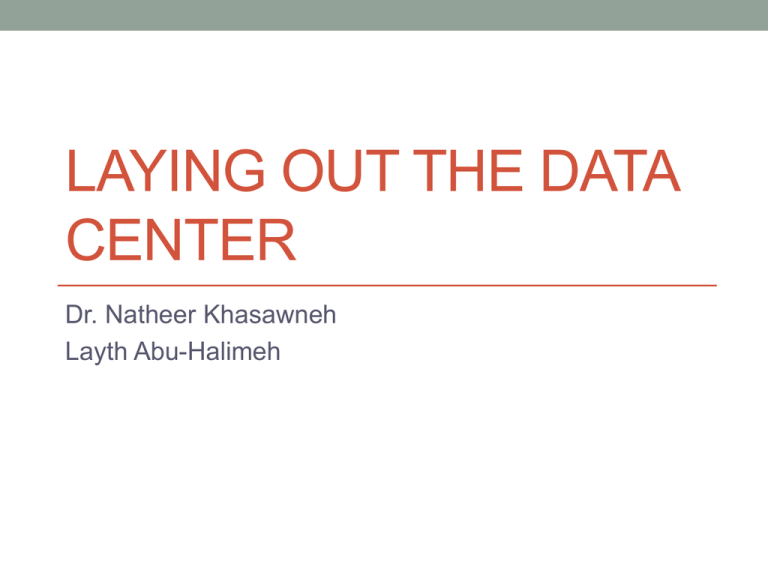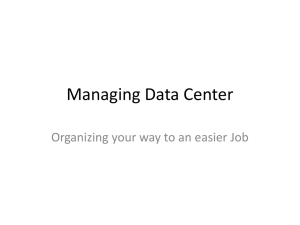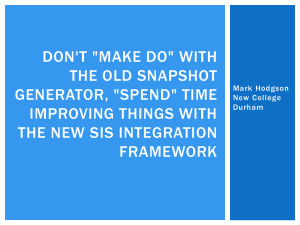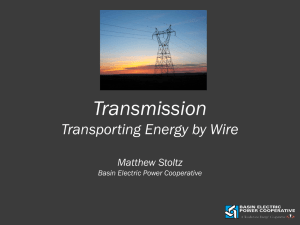04_Laying_Out_the_Data_Center
advertisement

LAYING OUT THE DATA CENTER Dr. Natheer Khasawneh Layth Abu-Halimeh This chapter will cover… • How to efficiently arrange all elements of a Data Center during the design phase, from large infrastructure objects to buffer zones to server rows. • How various server layouts affect the amount of floor space that rows occupy. • The best way to lay out a room when dealing with super heavy equipment, and how to accommodate unavoidable obstacles. • How to place essential Data Center infrastructure controls and what layout-related problems to watch for and avoid. Drawing Tools Available to Create Your Data Center Layout • One of the most effective ways to communicate the layout is the • • • • creation of a detailed map of the Data Center. Drawings are especially helpful if the contractors working on your Data Center have not built a server environment for your company before. Drawings provide a clarity and comprehensive amount of detail that written text can't. Using pen and paper is also the most primitive to sketch your data center. Several commercial software programs are available that can be used to draw your Data Center layout. Drawing Tools Available to Create Your Data Center Layout— continue… • Tools that are used around the world and that enable you to create sophisticated renderings of a server environment: • AutoCAD®, by Autodesk. • Visio®, by Microsoft. • Work with whatever media you're comfortable with and be sure that the maps you create are clear, detailed, and accurate enough to architectural firm that is to incorporate the maps into the Data Center's final construction documents. The Floor Grid • Start with a map of the building area the Data Center is to occupy • • • • and draw a grid over that space. The grid, consisting of squares 2 ft. (61 centimeters) on each side, helps align objects in the room and simplifies where to place everything. If you intend to install a raised floor in the Data Center, also use this grid to represent floor tiles, because the grid squares are the same size. If you draw the Data Center on graph paper, use the squares on the paper for the floor grid. You want to make full use of the floor space within the server environment, and if measurements or placement of key items are off by just a few inches (centimeters), problems can arise. The Floor Grid -- Continue… • It is crucial to correctly place your room's floor grid. • In most cases you want the grid's lines to synchronize with the Data Center walls. • Aligning the grid lines with the walls: • Makes it simpler to install the raised floor. • Requires fewer floor tiles to be customized for the room, which means reduced time and labor costs. • If a Data Center device comes to the edge of a floor tile, enabling you to lift an immediately adjacent tile for access, you can plug in to or unplug from the under-floor infrastructure by simply crouching down and reaching any necessary data ports or electrical receptacles. • Bring a flashlight (torch) if the tile opening is not immediately adjacent to the device. A Poorly Aligned Data Center Grid: A Disk Library, Air Handler, and Structural Column Overlap Multiple Floor Tiles A Well Aligned Data Center Grid: Repositioning the Grid Enables the Same Objects to Overlap Fewer Tiles Defining Spaces for Physical Elements of Your Data Center • Mechanical equipment, mandatory clearances, walkways, server rows, and miscellaneous obstacles are all pieces that must be interconnected properly for the server environment to function efficiently. • There is no number on the side of the wall saying how many pieces your server environment has or what it must look like when finished. • You are just left to fit as many servers, networking devices, and infrastructure elements into the room as you can. • Concerns are: • Place of air handlers, power distribution units. • How wide do you make the areas surrounding each server row? • Direction the rows should face. Defining Spaces for Physical Elements of Your Data Center • To best lay out your Data Center, define the amount of floor space that each item must occupy in the room and arrange each strategically. • Whenever possible, overlap clearance areas so that they do double-duty in the room. • For example, if a power distribution unit requires a buffer area to protect surrounding equipment from electromagnetic interference and an air handler needs a clearance area to swing open an access panel on the side, place these two items in mutual proximity. The buffer for one can serve as the clearance area for the other. This conserves space in the Data Center and enables it to be used for other purposes. Mechanical Equipment • The largest individual objects in a Data Center are typically its major infrastructure components: • Power distribution units that provide electrical power • Air handlers that regulate cooling • Fire suppressant containers • Because this mechanical equipment is essential for a server environment and can take up large chunks of floor space, place it on your Data Center map first. Power Distribution Units • A typical size used in server environments is about 7 feet wide and 3 feet deep. • The closer a unit is located to the server cabinet locations it feeds, the shorter its electrical conduits need to be. • They generate electromagnetic interference and, even with shielding, shouldn't be placed within close proximity to servers or networking devices. Air Handlers • Installed along the walls at regular intervals to provide even cooling throughout the server environment. • Best to place them perpendicular to your server rows. • Air handler A is in the middle of the Data Center floor. Placing the unit here occupies floor space that might otherwise hold server cabinets. • Air handler B is against a Data Center wall. Although the placement is an improvement over the placement of Air handler A, the unit is parallel to the room's server rows and will therefore be less efficient at cooling. • Air handler C shows the preferred placement—against a wall, perpendicular to server rows. Fire Suppression Tanks: • Set aside space for the cylinders containing fire suppressant that is to be dispersed into the Data Center in the event of a fire. • The larger the Data Center space the fire suppression system must cover, the larger the cylinders are likely to be. • Place these tanks in a lockable closet outside of but immediately adjacent to the server environment. • A Data Center can contain fire suppression cylinders under the raised floor, but this is less desirable (more exposed to damage and can restrict airflow). Buffer Zones and Aisles • Buffer Zones: • Building codes in many areas prohibit Data Center doors from opening outward into a main corridor, so clearances must be provided inside the room. • Aisles: • Don't overlook the aisles when laying out the room and don't skimp on them • • • • when allocating floor space. They enable people and equipment to move or be moved easily through your server environment and promote good air circulation. When planned poorly, these thoroughfares become the first trouble spots as a Data Center fills with servers. Building codes in many regions require minimum walkways of 36 or 42 inches . A server environment with insufficient aisle space is more likely to have difficulty regulating temperature and hosting large equipment. Primary Data User Station; the name for the equipment used to receive digital data from Meteosat. Analogue images are also transmitted by Meteosat (SDUS Secondary DUS) but these are of lower quality, resolution and usefulness for scientific applications, and are not received at Dundee. Defining Spaces for Physical Elements of Your Data Center—Continue… • Equipment Rows: It’s the final space to lay out is, ironically, the one most people probably think of first when discussing a Data Center. • Form Versus Function • Do you cluster servers by task so that devices performing similar functions are together? • Do you group them according to your company's internal organization? • Do you organize them by type so identical models are together? • Setting Row Dimensions • The majority of servers and networking devices in your Data Center are going to be installed into server cabinets that are one of a few dimensions common to the server industry generally about 24 inches wide and anywhere from 30 to 48 inches deep. • For width, decide how many cabinets you want each row to house and set aside the appropriate amount of space. • You may need to include one or more cabinets in the server row to act as a networking substation. • When choosing the width and depth of your server rows, translate them into how many floor tiles they occupy. Defining Spaces for Physical Elements of Your Data Center—Continue… • Networking Rows • Some cabinets house networking equipment that enable your servers to communicate • • • • with one another. You need to include a networking row in the Data Center layout. It is more common to cluster the major networking devices together in their own row and then have servers throughout the room connect to them. Because the networking row houses less equipment, it doesn't need to be as wide as the servers row. If you have the available floor space, however, it is not a bad idea to match its width to that of the server rows. • Orienting Rows • The final layout detail for your server rows is how to orient them. • Devices within a row to face the same direction for simplicity and consistent organization. • One popular strategy is alternation of the direction of server rows. This configuration can create distinct hot and cold areas in your Data Center. • While this may sound like a problem, creating hot and cold aisles is a popular tactic for regulating temperature in a server environment. Defining Spaces for Physical Elements of Your Data Center—Continue… • Orienting Rows—Continue… • Second approach to orienting server rows is to have all of them face a single direction. • This creates fewer concentrated hot spots than the alternating approach, but the exhaust of one row exhausts toward the intake of the row behind it, which makes the need for abundant aisle space in between crucial. It also cuts in half how many patch cords and power cables are located in any given aisle. Weight Issues • Data Center devices big and small have gotten heavier, putting greater strain on the rooms and buildings that house them. • Rows have the greatest weight-bearing ability and are prime locations to place your heaviest equipment. • The additional unoccupied space enables them to support items with overly large footprints, which is helpful because big equipment is usually heavy as well. • Unoccupied extra area lowers the overall weight on the Data Center floor, therefore enabling other nearby cabinet locations to support more. Seismic Mitigation • If your Data Center is in a region where earthquakes occur and you choose to install isolation platforms to mitigate their effect, increase the amount of space allocated for any server rows that they are installed in. • This is to accommodate both the footprint of the platforms themselves, which are usually made to match the size of the server row they are installed in, and the additional range of motion they require to function properly during a quake. This movement is typically about 10 inches (25.4 centimeters) in every direction. Dealing with Obstacles • Most obstacles are characteristics of the building you are in, oddly shaped floor spaces and support beams. • Irregular Spaces • If your server environment does have irregular spaces, they are probably unsuitable for hosting servers. They may serve another function, however, and should not be forgotten when designing the Data Center. • If you have an odd space, try to make it useful. Maximize every square foot (meter) of Data Center floor space. • Structural Columns • The larger your server environment, the more columns it is likely to have. • They enable Data Center server rows closest to them to support greater weight loads. • But they are also an obstruction to positioning server cabinet locations. • It is easier to orient Data Center elements in relation to a consistent wall than to have to work around dead space created by the column. • For columns located in the middle of the Data Center floor, design the external area of each column to be as small as possible. Dealing with Obstacles — Continue… • Piping • Two Data Center infrastructure systems—cooling and fire suppression—include associated piping that must reside in your room. • Tuck the chilled water pipes that flow to and from the room's air handlers close to the units themselves. • Place water feeds for the sprinkler system outside of the Data Center or, if inside, in a rarely trafficked corner of the room or perhaps in a dead space against a structural column. • Construct a solid frame around them with an access panel to reach their controls System Controls • Place the controls for key Data Center infrastructure immediately inside the main entrance(s) to the room. • controls to • Cut off electrical power in an emergency. • Controls to manually deploy or abort the fire suppression system. • And even switches for the room's overhead lights. • Installing controls 44 inches (112 centimeters) above the surface of the floor is common and enables most people to reach them from either a standing or seated position. Telephones • Wall-mount them in strategic locations so that someone standing in front of practically any server, networking device, or infrastructure component can make a phone call. • Install long cords between the handset and receiver of each telephone and make sure that the phones are configured to call external numbers.










